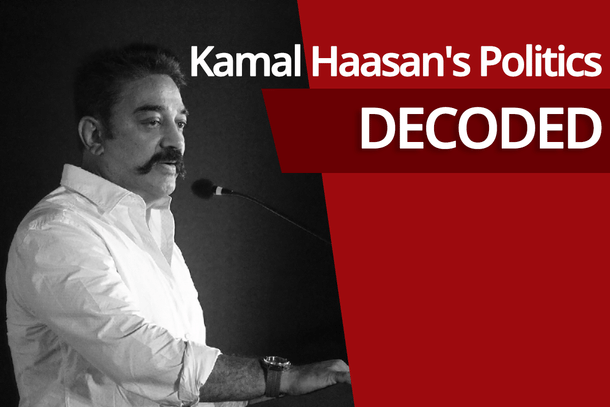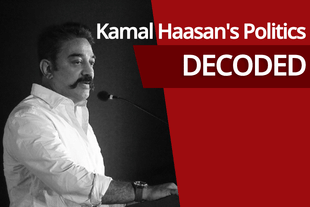Videos
Kamal Haasan’s Confused Ideology
Swarajya Videos
May 21, 2019, 06:53 PM | Updated 06:53 PM IST
Save & read from anywhere!
Bookmark stories for easy access on any device or the Swarajya app.


Transcript:
Actor Kamal Haasan, who is, of course, now also president of his Makkal Needhi Maiam party, kicked up a bit of a storm last week when he said independent India's first terrorist was Hindu, and his name is Nathuram Godse.
Take a listen.
This obviously upset the Sangh Parivar, with the BJP even petitioning the Election Commission to act against Haasan and his party.
AIADMK legislator and Tamil Nadu minister K T Rajendra Balaji's rage was apparent after he said Haasan's tongue should be chopped off.
A more mellow Shiv Sena’s Sanjay Raut said, “Hindus will not tolerate it when their religion is linked with terrorism."
There were essentially two reasons why there was an outpouring of anger among certain groups: 1) Godse was an RSS man, and 2) Haasan's comment seemed to fall in the line of the Congress, Communists, and others showing Hindus in poor light to try and draw some minority votes for themselves.
And Haasan's idea itself was a bit testy - whether terror has a religion is debated often on social media. And generally, the debate swings one way or another depending on the religion of the perpetrators.
But, for this episode of Swarajya Standard, we'd like to draw your focus to Kamal Haasan's ideology. Is the actor-turned-politician consistent in his criticism of bigotry, of regressive attitudes, of toxic practices across religions and schools of thought, or is he selective in his approach, biased?
For that, we can look at the movies he's chosen to do in his career, including the ones he has written himself. In doing that, we see apattern emerge - of a certain ideological position that he likes to take.
Our contributing editor Aravindan Neelakandan has written a couple of incisive commentaries on two of Kamal Haasan's films - one is Anbe Sivam and the other, Hey Ram.
Anbe Sivam, Aravindan writes, appears to carry a message of humanism, but its portrayal of various religions is troubling. For example, Hinduism is associated with exploitation and is often the religion of the negative characters. Such as the industrialist who violates labour laws and is a hypocrite who says he won't touch water on an auspicious day but is later seen drinking alcohol.
Contrast this with the portrayal of Kamal Haasan’s Marxist protagonist, who after a severe accident, gets rescued by Christian missionaries - Roman catholic nuns - who give him care and support.
The association of the Hindu symbols with negativity persistently runs through Anbe Sivam.
Let's take the other case: Hey Ram.
Here, Haasan draws a connection between Hindutva and Nazism. In one scene, one can see portraits of Hitler and Savarkar put up on a wall in a room where an assassination plot is being discussed.
In another instance, the traditional Swastika is seen melding into the iron Swastika of Nazis and then into an iron lotus, making the attempt at drawing a link between Hinduism and Nazism more direct.
Haasan also puts forward the Aryan invasion theory in Hey Ram, even though it was established by then that the model doesn't hold water.
In these two movies, Haasan the writer seems at ease portraying Hinduism as irrational, corrupt, even evil. And being unapologetic about it.
On the other hand, look how he responded to protests against his film "Vishwaroopam" by Muslim groups - they asked for a screening before release and he obliged. They even asked him for cuts in the movie. He went out of his way, then, to suggest that he wasn't portraying the community in a poor light and that some individuals were good and others bad.
And for claiming to be a firebrand atheist and Periyarist all his life, he has not had a problem "spreading the word of the Christ," as he admitted once in an interview to Karan Thapar.
Fact is, it seems like Hinduism is the only religion he has a problem with, and one he likes to attack through his art. The bigotry or illiberalism of other religions gets a free pass.
What is apparent is that Haasan probably doesn't want to carry the burden of his Brahmin birth in Dravidian land. His Brahmin identity hangs over his head like the Sword of Damocles. So his pattern of selectively taking potshots at Hinduism alone gives him a way out of this problem. Perhaps he looks at taking a stand against Hindu outfits, as, Aravindan, "his passport to the realm of Dravidian acceptance".
Of course, one is free to choose an ideological position and run with it. Especially as an artist, you will more often than not have an idea or message that you'd want to put out there through your art. Kamal Haasan has just been doing that. But now, as he enters the political arena, his ideological position, his politics, will draw interest. And not just interest. It will be tested and scrutinised, too. And if there is selectivity, bias, or hypocrisy, like it appears now that there is, it will be pointed out, and Haasan will have to face up to it.
The actor will have to brace for much more of this scrutiny in the coming months.
*
Here’s a short list of stories that you can read to learn more about Kamal Haasan and his ideology:
Anbe Sivam: Stairway To The Pseudo-Secular Heaven
The False Symmetries Of Hey Ram
Kamal Haasan’s Dravidianism Version 2.0?
Kamal Haasan Now, Gandhi Then: The Urge To Invent Hindu Sins For Every Act Of Islamist Terror
*
Subscribe to Swarajya on YouTube to keep up with our regular stream of videos.





